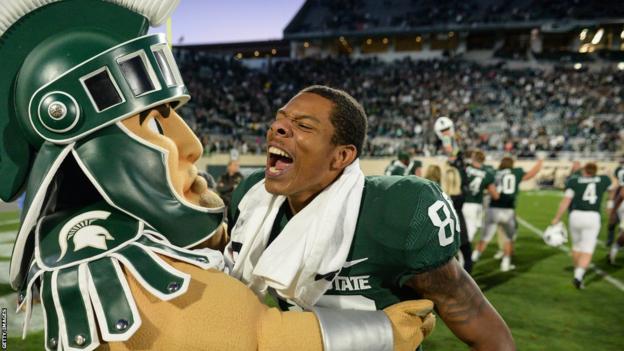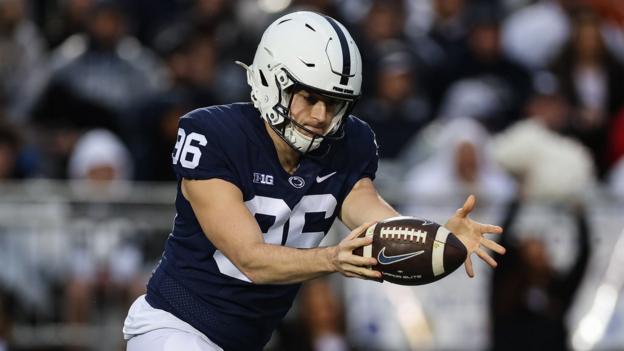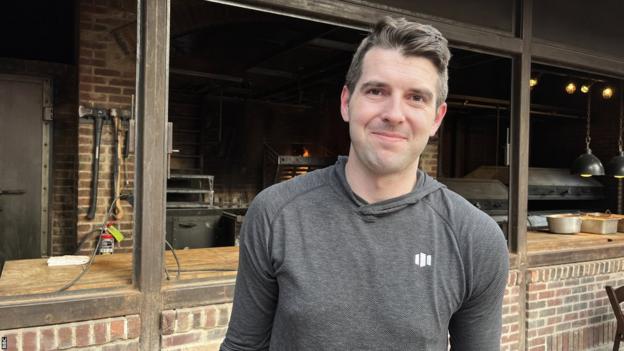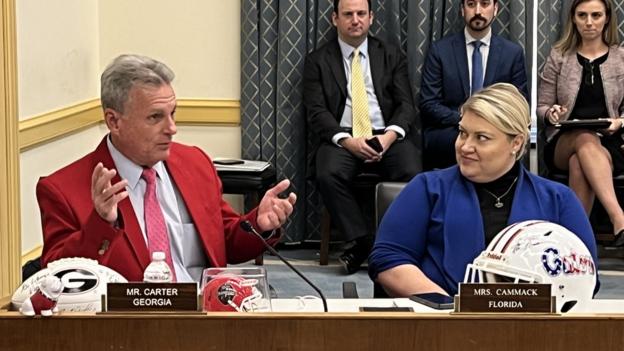
Sign up for notifications to the latest Insight features via the BBC Sport app and find the most recent in the series
College football in the US is big business. The sport, which kicked off its new season last weekend, is awash with money.
The 65 universities in the top five athletic conferences generated a combined total of more than $3.3bn (£2.6bn) in revenue from their American football programmes alone last year.
Starting next season, the 18 universities in the Big Ten Conference – traditionally one of the strongest and most prestigious college gridiron competitions in the country – will share more than $1bn a year (£792m) in television broadcasting money.
The coaches who run these top football programmes also earn extraordinary sums. Nick Saban, coach at the University of Alabama, topped the list at $11.7m (£9.3m) in 2022. Kirby Smart, the University of Georgia head coach who has won the past two national championships, was just behind, at $11.25m (£8.9m).
Name a state – Florida? Iowa? California? North Carolina? – and chances are the highest earner on the government payroll is a college football coach at one of the state’s public universities.
The significance of the sport in the United States goes beyond dollar figures, however. It is woven into the cultural fabric of communities across the nation – particularly in the midwest and south, where spectators fill stadiums, some with seating capacities of more than 100,000.
Of the 10 largest sports stadiums in the world, eight are US college football venues. On Saturdays in autumn, the population of towns like Ann Arbor (University of Michigan), State College (Penn State), Tuscaloosa (Alabama) and Baton Rouge (Louisiana State) come close to doubling in size due to the arrival of loyal fans from across the region.
Outside the stadium walls, a national television audience numbers in the millions. Last year’s national championship game between Georgia and Texas Christian University attracted 17 million viewers.
Thirty-five million tuned in to the 2006 national championship game between two undefeated college powers at the time, the University of Southern California and the University of Texas – a game the Longhorns won with a dramatic last-ditch touchdown.
Despite being marinated in cash, however, college football is still technically an amateur sport.
The players on whose backs the multi-billion-dollar industry operates are not financially compensated by the universities for which they play.
They receive scholarships to cover tuition, housing and food, as well as monthly stipends for expenses. Some scholarships are not guaranteed, however, and they all can be revoked for non-athletic reasons. And while healthcare is provided for those enrolled in school, it does not continue after collegiate careers end – even if the injuries sustained on the field linger.
College athletes who violated rules were subject to severe punishment.
In 2010, for instance, five Ohio State football players – including the star quarterback – were suspended and had their names erased from the college record books for trading sport memorabilia for free tattoos at a local Ohio parlour.
It is an imbalance that has struck many college football observers as inherently unfair.
Consider the following reasoning:
“Nowhere else in America can businesses get away with agreeing not to pay their workers a fair market rate on the theory that their product is defined by not paying their workers a fair market rate.
“Enormous sums of money flow to seemingly everyone except the student athletes. College presidents, athletic directors, coaches, conference commissioners, and NCAA executives take in six- and seven-figure salaries. Colleges build lavish new facilities. But the student athletes who generate the revenues, many of whom are African American and from lower-income backgrounds, end up with little or nothing.”
Those words were written by Justice Brett Kavanaugh in an opinion concurring with a landmark 2021 Supreme Court decision striking down limits on compensation for student athletes.
That decision, along with recent changes in collegiate rules prompted by lawsuits and state legislation, has cracked open the bank vault doors, allowing college athletes to begin to more fully enjoy some of their sport’s largess.
For the past two seasons, college players have been able to sign deals to allow third parties to use their “name, image or likeness” – NIL, for short – and receive money in return.
It could be as little as a few hundred dollars for an autograph-signing session or as much as hundreds of thousands of dollars for a national advertising campaign.
The money is flowing across every college sport. Some women’s basketball players claim to be earning more through endorsement deals in college than they would in the WNBA professional league.
A gymnast at Louisiana State University – Olivia Dunne – posed for the Sports Illustrated swimsuit issue and says she earns more than half a million dollars for a single social media post.
But with about half of all NIL money going to college football according to industry estimates, it’s that sport’s star players who rank among the top earners.
Bryce Young, the University of Alabama quarterback chosen first in the NFL draft earlier this year, reportedly earned more than $3.5m (£2.8m) in NIL deals over the course of his collegiate career, with a sponsorship portfolio that included BMW, Beats by Dre and Dr Pepper.
Those Ohio State players who were suspended for free tattoos back in 2010? Now they could sign a sponsorship deal that gives them tattoos – and pays cash, too.
The new NIL rules have also provided a back door through which supporters of college football teams – whether deep-pocketed alumni or groups of casual fans – can step in to fill the void left by universities, funnelling money to players to reward them for performance on the field and, perhaps, lure more gifted athletes to join.
Supporters have pooled resources to form ‘collectives’ with names like Rising Spear (Florida State), Golden Touch (Notre Dame) and the Big Red Collaborative (Nebraska). A University of Texas group, Texas One, provides $50,000 a season to every offensive lineman on the Longhorn team – in exchange for a handful of charity appearances.
The ground on which college football’s business empire has been built is shifting.

Barney Amor began playing college football under the old rules. Born in the Netherlands to British parents, he grew up with European football, only taking up the American version while attending high school in Pennsylvania.
He set numerous school records for his kicking, however, drawing on his earlier experience playing the other kind of football as a youth. Colgate University, a small liberal arts school in central New York, gave him a scholarship to be the team’s punter – the player whose sole job is to kick the ball as far down the field to the opposing team as he can when his side’s offense sputters.
It was small-time college football, more akin to the way the game was played before the big television contracts and luxury stadiums changed the sport forever.
At Colgate, Amor recalls, the football games would only attract around a thousand fans. “And half of them were parents of players,” he jokes.
Amor won recognition for his kicking skills, however. And after earning an undergraduate degree at Colgate and sitting idle because Covid caused the cancellation of the team’s 2020 season, he decided to try for the big time. He was admitted to graduate school at Penn State University and given a spot on the Nittany Lions team, where instead of playing in front of a few thousand fans, he was on the field before crowds of a hundred thousand – with millions more watching on television.
During his two years at Penn State – serving as the starting punter on a full-tuition scholarship in year two – Amor watched as NIL changed from a minor curiosity for players into a major undertaking.
“When it all started, everyone thought it would be a couple hundred bucks,” he says. “But it’s a basic supply and demand thing. How high are they willing to go?”
Pretty high, it turns out. He says now the top players on the team are driving fully loaded Teslas and Range Rovers that are provided through car dealership NIL endorsements.
“I think it gets tricky,” Amor says. “A team is bringing in a billion dollars through TV deals. But it’s kind of hard to justify when the professors are bringing in a different realm of cash.”
As the team’s punter, Amor was by no means a star. But after realising the potential of NIL income, he set out to turn what fame and attention he did have into a steady income. He says he visited the local business association and copied their membership directory. He then went down the list, pitching his endorsement services to anyone who would hear him out.
“If you make 100 phone calls and one of them comes through, it’s all worth it,” he says.
Amor signed a deal with a local doughnut store. Because he liked to bring his own pillow to hotels the night before games, he inked an endorsement with a home goods store and carried one of its pillows as he walked into the stadium on game day.
He recorded a viral video for a Pennsylvania healthcare company in which he asked Penn State fans who didn’t recognise him how he could make the punter their favourite player.
“I think the crazier ideas get a lot more media attention,” he says. “You’ve got to be a little bit out there.”
For his efforts, he was nominated as a 2023 NIL innovator of the year at the NIL Summit, a conference of sports professionals and college athletes.
He won university recognition for the highest grade-point average among seniors on the football team. And he had success on the field, finishing the 2022 season with the second-longest average punt distance in Penn State history, earning consideration for the national punter of the year trophy.
Amor says playing football at the highest level while attending classes and managing a growing NIL business took considerable effort, however.
“Whether it’s going to mandatory breakfast meetings, going to workouts, going to class, going to study hall, going to meet with advisers, going to do extra work, everything is scripted,” he says. “You’re talking six, seven in the morning till sometimes 10 o’clock at night.”
Some players, he said, are unable to juggle a loaded academic and athletic schedule while also handling their financial obligations. And others have the kind of financial success while in school that sets them up for trouble after graduation, when a professional football career doesn’t materialise and the money dries up.
“You become accustomed to a lifestyle that’s not sustainable,” he says. “And if you don’t have the financial intelligence or financial background to do anything about it, how do you adjust?”
While the NIL money has been a boon for many athletes, there’s a growing concern among college administrators and other involved parties that the money now flowing to the players is spinning out of control.
As a professor of advertising at the University of Texas, Natalie Tindall says she has watched college athletes struggle to keep a handle on the changing NIL landscape.
“We have to remember that these people are still in their teens and early twenties,” she says. “We’re asking them to be exceptional in athletics, academics and this other new thing, without realising how much of a time suck it can be.”
What is more, she says, much of the NIL effort is what is called aspirational labour – time, effort and money spent with no guarantee of an adequate financial return on the investment.
“It can be incredibly overwhelming,” Tindall says.
The University of Texas tries to help. It has financial counsellors for all its student athletes. It offers classes on NIL, brand marketing, managing social media and sports negotiations. The university has also partnered with Opendorse, an NIL marketplace company, to allow its athletes to easily create a personalised web page where they can solicit and manage endorsements.
For instance, fans can offer at least $36 to get a personalised video greeting from Cedric Baxter, a top-rated Florida high-school running back who will play for the Longhorns this year. For $125, he will attend a local event. Autographs start at $258. There’s also a ‘deal builder’ function for businesses to customise a more lucrative pitch for Baxter’s services.
Last year’s starting Texas running back, Bijan Robinson, had a sponsorship deal with a local Lamborghini dealer – car lease included – and his own line of Dijon mustard in Texas grocery stores.
Robinson was drafted by the NFL and will play for the Atlanta Falcons this coming season. But in his last year of college, his NIL earning potential was estimated by college sports market analyst company On3 to be around $1.8m (£1.4m).
Opendorse’s chief executive Blake Lawrence played football at the University of Nebraska from 2007 to 2009, before quitting the game because of repeated head injuries. He says he would have loved to have been able to hustle for extra money while he was on the team. But even though his business now depends on the rapidly expanding world of NIL finances, he’s clear-eyed about what it means for the sport.
“NIL has opened a Pandora’s box that can’t be closed,” Lawrence says. “It’s going to separate the haves from the have-nots.”

For decades, the University of Alabama has been one of the haves in college football. The Crimson Tide, under head coach Saban, have won six national championships since 2009 and regularly recruit top-ranked classes of incoming high school athletes. The university’s athletic department ranked third in the nation in revenue in 2022, with $214m (£170m).
The school’s athletic director, Greg Byrne, sees storm clouds on the horizon, however.
For the moment, college football is the cash cow that funds a range of other university athletic programmes that don’t generate profits. If the money coming into athletic departments from donors and supporters is redirected to NIL payments to athletes, it could destabilise the whole system.
“We have a very flawed financial model,” Byrne says. “So the question is, where does that money come from, to be able to support broad-based programming? I think that’s really important to make sure that’s part of the discussion.”
Byrne also bristles at the idea that college athletes are “unpaid labour”, noting that the university spends about $160,000 a year in room, board and tuition for scholarship recipients. He also notes that with off-campus housing allowances and government grants, Alabama athletes receive about $42,000 in tax-free cash to spend as they like.
“I think those are things that at least need to be recognised in the conversation when you talk about the model of what takes place in college sports,” he says.
Byrne says he would like to see guidelines and reforms implemented on a national level, through legislation in Congress, that will standardise what are currently a jumble of rules and regulations that vary from state to state.
There is a case to be made that schools and athletes should disclose their NIL receipts to separate fact from rumours. In one well publicised episode, a California high school quarterback thought he would receive a four-year, $13m endorsement deal from an NIL collective if he signed to play at the University of Florida. After he committed, the agreement fell through.
The player, Jaden Rashada, was said to be considering legal action even after the university let him out of his commitment to play for the Gators. He’s now the starting quarterback at Arizona State University, but his story serves as a cautionary tale that all is not always as it appears in today’s college football world.
If athletic directors like Byrne are calling for national reform, some members of Congress are listening. Whether there is the political will to do anything about it, however, is an open question.
Legislators have proposed more than a dozen various laws, but so far none have advanced beyond the drafting stage.
“The main question before us today is how Congress should regulate this new economic frontier to ensure that NIL deals are transparent and fair, and that they do not compromise the integrity of college sports,” said Republican Gus Bilirakis, at a March hearing at the House of Representatives.
“The lack of uniformity across different states and institutions has created confusion and uncertainty, and a federal standard is needed so all athletes are playing by the same rules.”
What those rules could turn out to be, however, remains anybody’s guess, as the discussion among legislators during the hearing occasionally veered toward comedy, with good-natured sparring over college team allegiances.
After Congresswoman Kat Cammack of Florida placed a University of Florida football helmet behind her nameplate on the committee lectern, Congressman Buddy Carter, with the help of his staff, surrounded his with a University of Georgia football, one of his university’s helmets and a small figurine of the team’s bulldog mascot.
“We all love college athletics, and that’s why we’re so concerned about this,” Carter said. “We don’t want to see it ruined.”

Jason Stahl, executive director of the College Football Players Association, was one of the panellists at the hearing. He said that although he opposes new federal regulations of college athletics, he didn’t hear anything new or concrete during the day’s proceedings.
“I think the thing that surprised me the most is you have Republican members of Congress who seem comfortable using the federal government to intervene in this one particular free market,” Stahl said. “Why this one thing? Should we have the federal government coming in with an overbearing piece of legislation to govern this one free market? I don’t get it.”
If Stahl had his way, college athletes would come together in a union-like organisation that could license agents who deal with NIL contracts and could demand revenue-sharing and long-term health benefits directly from the universities.
Now that NIL has put increasing amounts of money in the hands of football players, the power dynamic in college athletics is shifting. Combined with loosened restrictions on transfers between schools, a college version of free agency – the player rights shift that changed US professional sports forever in the 1970s – is crashing through the college ranks.
Every year, thousands of players switch between teams – whether for more playing time, better professional prospects, friendlier coaching or, perhaps, more NIL money.
Stahl, who sees a future where college athletes break the back of an unjust system and are finally the ones calling the shots, believes he is on the winning side.
“I think universities have to realise that athlete empowerment is here to stay,” he said.

